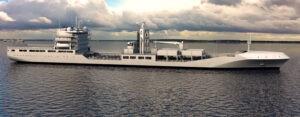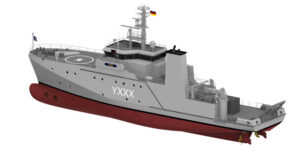Important major projects were finalised just in time for the German parliamentary elections. These procurements will characterise the navy for decades to come.
On 23 June, before the summer break, the Defence and Budget Committees of the German Bundestag presented 27 so-called 25-billion-euro bills with a total volume of over 19 billion euros for the German Armed Forces for approval and gave the green light for procurement. The navy will receive 7.3 billion euros of this to procure three fleet service boats, two double-hull tankers, two submarines (U 212CD), five maritime reconnaissance vessels, two measuring boats for WTD 71 and to modernise the frigates 123 and the FRANKENTHAL-class minehunters (MJ 332C). These urgently needed armament projects serve to replace older units and to bring them up to the latest technological standards. Apart from two new submarines and the five corvettes 130 currently under construction, the procurements will not lead to a significant increase in the number of flagships. The number of maritime patrol vessels is even being reduced. The German Navy still has the smallest fleet in its history.
Replacement of the Class 404 tenders, MCM units and support vessels such as harbour tugs, diver intervention boats and security boats has not yet been negotiated. Nevertheless, the navy is relieved and grateful, as the ageing of the fleet is being halted. Overall, the fleet will only grow slightly over the next twelve years with the four frigates 125, the five corvettes of the second batch, the four commissioned frigates 126, the two submarines, the 18 Sea Lion helicopters and the new 31 Sea Tiger helicopters, but it will become more modern and more powerful.
The political leadership of the recently expired legislative period recognised that the Bundeswehr needed greater financial resources and provided a remedy with the 27 procurement projects. It remains uncertain whether the next governing coalition will also realise this and be able to stop the years of underfunding of the Bundeswehr.

Fleet service boats
On 23 June 2021, the Federal Office of Bundeswehr Equipment, Information Technology and In-Service Support (BAAINBw) concluded the contract for the design and construction of three Class 424 fleet service boats. Lürssen Werft is to supply the three fleet service boats as well as a training and reference facility for 2.1 billion euros. The 130 metre long units will be built to civilian standards with a displacement of 4000 tonnes and will be equipped with state-of-the-art electronics and complex systems for reconnaissance above and below water, as well as systems for self-protection and command and control. This also includes a low-noise propulsion system. The plan is to put the first fleet service boat into service in 2027. The new ships will then replace the over 33-year-old Class 423 units from 2027.
Fuel transporter

The BAAINBw has awarded Lürssen Werft the contract (944 million euros) to build two new class 707 fuel transporters for the navy to replace the over 46-year-old single-hull tankers RHÖN and SPESSART class 704 from 2024. Lürssen intends to work together with the Meyer Werft shipyard in Papenburg to build the ships. The new 170-metre-long double-hull tankers will displace 20,000 tonnes, comply with IMO guidelines in terms of environmental protection and have ballast water treatment systems and exhaust gas aftertreatment systems to reduce emissions. They also fulfil the NATO requirement for NBC suitability. They have a cargo capacity of 12,000 cubic metres of diesel and aviation fuel and a range of 8,000 nautical miles at 18 knots. The crew will consist of 95 people. With the appropriate stations, up to three refuelling operations can be carried out simultaneously. On the upper deck there are modular container bays for tools and spare parts. The tankers will have an infirmary and a helicopter landing deck for the operation of NH 90 helicopters.
Submarines
On 8 July, the Norwegian procurement authority and the BAAINBw signed contracts with Thyssenkrupp Marine Systems for the delivery of six Class 212 Common Design submarines - four for Norway and two for Germany. Construction of the first unit for Norway is scheduled to begin in 2023, with delivery expected from 2029. The two boats for the German Navy are scheduled for delivery in 2032 and 2034. The total order volume is estimated at 5.5 billion euros. The U 212CD is based on the design of the Class 212A submarines. The 73 metre long Class 212CD will displace 2500 to 2800 tonnes. It is capable of worldwide deployment. A new command, control and weapon deployment system (FüWES), Orcca, will offer enhanced capabilities in situational awareness and networking with maximum IT security. A missile system for defence against threats from the air is also planned. The German-Norwegian cooperation also includes the procurement of Naval Strike Missile Block 1A missiles for the German frigates.

Maritime reconnaissance aircraft
On 23 June, the Budget Committee allocated 1.3 billion euros for the procurement of five P-8A Poseidon maritime patrol aircraft for our naval aviators. The aircraft are to be delivered by Boeing in 2025. They will replace the current eight P-3C Orion maritime patrol aircraft, which were due to be decommissioned in 2025 anyway. Although only five instead of eight maritime patrol aircraft were purchased, the Poseidons will still serve as an efficient "interim solution" for the naval aviators to maintain their capabilities until 2035, when the planned Franco-German Maritime Airborne Weapon System (MAWS) is to be introduced as a maritime patrol aircraft and sub-hunter. In addition to the five aircraft, the procurement of the Poseidons includes the associated mission and communications equipment, spare parts, accessories, on-board test equipment and special tools, a mission support system as well as technical and logistical support and training.
Frigates class 123
The Budget Committee has earmarked 428 million euros to ensure the operational availability of the four BRANDENBURG-class frigates. To this end, the BAAINBw has commissioned the Swedish defence contractor Saab with the modernisation. The contract includes the delivery and integration of new ship radars and fire control systems. The delivery and other services are to take place between 2021 and 2030. This includes the 9LV command and weapon delivery system with the Sea Giraffe 4A and Sea Giraffe 1X radars, the Ceros 200 fire control system and other third-party systems. These include IFF capabilities, new Eloka UM/GM systems and an upgrade of the Mk 41 Vertical Launching System.
Minehunting boats class 332C
Five FRANKENTHAL-class minesweepers will be equipped with the latest version of the
Integrated Mine Countermeasures System (IMCMS). This has already been integrated on three boats in the class. On 9 July, following the parliamentary approval of the budget funds, the BAAINBw commissioned Atlas Elektronik with the delivery and integration of this command and weapon deployment system, with implementation planned between 2021 and 2025. This will standardise the technology for combating sea mines on the minehunting boats and enable the cross-sectional use of the training and testing facilities.
Measuring boats Sea trials Coast

The Wehrtechnische Dienststelle für Schiffe und Marinewaffen, maritime Technik und Forschung (WTD 71) in Eckernförde is to receive two new measuring boats Seeversuche Küste. The BAAINBw commissioned the Fassmer shipyard with the construction on 22 July. The boats will replace the two Class 745 units (MITTELGRUND and BREITGRUND) and the Class 741 WILHELM PULLWER barrage weapon test boat after 32 and 55 years respectively. The new ships will be built to civilian standards and modified accordingly for the special requirements of defence trials. Their tasks will include securing and recovering torpedoes, securing submarines during shallow water trials, deploying autonomous underwater vehicles and supporting diving operations as part of defence trials of diving equipment and gear. They are due to be delivered to WTD 71 as early as 2023.
Inflow of new units
The navy is initially procuring four Class 126 frigates, the former multi-purpose combat ship 180. The project, with a total volume of 5.27 billion euros, is one of the largest procurement projects in the history of the German armed forces. Together with the German partners Blohm+Voss as part of the Fr.-Lürssen Group and German Naval Yards Kiel, the Dutch shipbuilding group Damen Schelde Naval Shipbuilding (DSNS) intends to implement the construction project in such a way that around 80 per cent of the total investment remains in Germany as added value. The ships will therefore be built at the shipyards in Hamburg, Kiel and Wolgast. Construction is scheduled to begin in 2023 after completion of the design phase. The first F 126 could then be delivered from mid-2028. The four ships will gradually replace the four Class 123 frigates in the early 2030s.
The F 126 is intended to be an enduring, assertive and flexibly deployable naval weapon capable of all types of combat in three-dimensional naval warfare. It is based on the Class 125 frigate concept, which is characterised in particular by intensive use, a high degree of automation, low maintenance and a relatively small crew size based on the multi-crew concept. The 155 metre long ships are expected to displace around 9000 tonnes. This makes them 5 metres longer and 2000 tonnes larger than the Class 125 frigates.
With the addition of five new K 130s, the fleet's corvette fleet will increase to ten units. With the keel laying of the first ship, the KÖLN, the K 130 consortium, consisting of Fr. Lürssen Werft, Thyssenkrupp Marine Systems and German Naval Yards Kiel, started production in April 2019. So far, construction is proceeding according to plan. The KÖLN is scheduled for delivery at the end of 2022, with the other ships to follow by 2026.
The new corvettes are basically identical to their predecessors, which were designed 19 years ago. Since then, not only have new laws and regulations come into force, but technology has also evolved. This requires adjustments, changes and modifications to equipment and systems, particularly in the command and weapon deployment system, IT security and system networking. In addition, more powerful sensors and effectors are being integrated into the operational system. These include a new TRS-4D radar, a new Eloka system, Mirador Mk 2 and a new 76-millimetre Super Rapid gun. Other changes include a new water treatment system and new rescue boats.
Of the 18 NH 90 Sea Lion multi-role helicopters ordered, eleven have already been handed over to the naval aviators since 2020. All aircraft are to be delivered by 2023. The Sea Lion replaces the Sea King Mk 41, which has been in service since the mid-1970s and has long since reached the end of its service life. The Sea Lion is primarily used for tactical transport of personnel and material, maritime surveillance, SAR services, evacuation tasks and boarding. The helicopter can be equipped with two heavy machine guns and decoy systems.
In 2020, the budget committee released 2.7 billion euros for the procurement of 31 Sea Tiger helicopters with multi-role capability. From 2025, it will replace the Sea Lynx Mk 88A shipboard helicopter on the frigates, which has been in service since the 1980s. As a combat helicopter, the Sea Tiger is an integral part of the frigates. It is used for submarine hunting, to engage surface targets and also for transport tasks and SAR missions within a ship's convoy.
Author: Dieter Stockfisch










